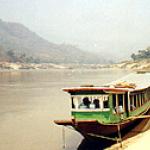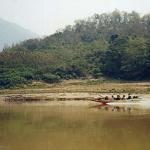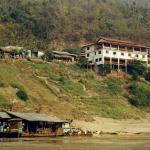The Sea of Laos - the mighty Mekong River
In Vietnam, it's called "River of the Nine Dragons." In Thailand, Burma and Laos, it's known as "Khong, Mother of Waters." For Tibetans, its appropriately known as "Water of the Rocks," describing its source from a frozen, rocky riverbed. The Mekong is Southeast Asia's greatest river and runs a total length of 4,200kms. As it hurtles out of Chinese territory, already half the Mekong Rivers' course is over, before it marks the boundaries of Laos, Burma and Thailand. Further south, it passes through central Cambodia and southern Vietnam before finally draining into the South China Sea!
Laos actually has the greatest share of the Mekong River. It's vitally important to the country; even the broad blue stripe in their National Flag represents the Mekong. With few good roads and mountainous terrain, these waters are Laos' principal transportation and communication artery, and its' predominant fishing area. Not for nothing is the Mekong called the "Sea of Laos." But then that's hardly surprising, given that Laos is landlocked.
The Upper Mekong in Laos is considered one of the most stunning journeys of the entire river. I was not only privileged to travel this route, but also with probably the most appreciative group imaginable. The small fact that their average age was 57 didn't really seem to matter one iota. The starting point for great adventure was actually up in the north-east corner of Thailand, at Chiang Rai. From here, our group of seven plus our (Australian) guide drove to Chiang Khong, the border crossing on the banks of the Mekong. Across the water, directly opposite stood the riverside town of Huay Xai, gateway to the Kingdom of Laos. The Thai border post lead down to a steep descent, where small, wooden crafts bobbed on the water ready to take us across. I had seen the Mekong River before and I had travelled along it in Vietnam. Yet as we descended the hill and for the first time saw this mighty river, it still managed to take my breath away. Deep, broad and with a pale brown hue, it rushed along in perpetual hurry contradicting its slow, languid surroundings. The river was almost hypnotic: what stories it held of former Indochina days.
Laos
Within a short time, our boat had gently brought us across to Laos. For the entire group, this was the realisation of an overdue dream. Our first encounter with Lao officialdom at the riverside border post was surprisingly laid back and our local guide seemed genuinely delighted to welcome us to his country. Already we spotted what was to set a familiar scene in Laos: the ubiquitous wat, high above on a hill. Its' detailed low sloped two-tiered roof and brightly coloured outer murals were still intact; around which resident saffron-robed monks went about their business. The steep climb up the wats' never-ending steps in the midday furnace made the entire group's thoughts switch abruptly to lunch and shade. So we entered a sleepy wooden shack of a riverine restaurant. With no one actually dining inside, they must have thought Christmas (or their equivalent) had come early, invaded by a group of ravenous westerners. This called for a quick scuttle to the nearby market to stock up on extra provisions. I hadn't come all this way not to try the local "fruits of the river." The fragrant steamboat fish soup with lemon grass and chillies was awesome. I was none the wiser of its name, but it was so fresh it could well have been swimming along the Mekong a few hours ago.
The day's plan was to head downstream to Pakbeng and be whisked away, literally, on speedboats (heua wai.) Not the James Bond shiny fibreglass numbers you understand, but six-seater wooden, long, thin boats with an outboard engine at the back. The seat was a narrow wooden plank for two, sitting very low on the water. Laos surprisingly is fairly vigilant on safety and dispensed helmets and life jackets. The trouble is, this made you a tad nervous about the imminent journey. I eyed our "drivers" suspiciously. They did look rather young and I just prayed that they had laid-off the rice wine at lunchtime. Tightly gripping the sides we roared off, the "G-force" whizzing past the visor of my helmet. The first few minutes I was too preoccupied to take in the stunning beauty of the surroundings: the towering mountains and densely forested slopes. When I realised however the maturer "youngsters" of the group were evidently having the time of their lives, I felt stupid and settled down.
The drivers adeptly angled the boats as we manoeuvred past submerged rocks, slipstreams and gentle rapids amongst narrow waterways. All the while, the steady froth of water continually ran along side our elbows. This was the scenario for the day; just sit inert and take in the wondrous surroundings as life hurtled past. Not that there was a lot of life. Laos is a desperately underpopulated country and in these rural areas settlements are few and far between. The river was eerily empty and the deafening whine of the engine seemed rather out of place, disturbing the timeless tranquillity. It was almost our river; that is until the odd speedboat veered past us full of helmet-wielding travellers and locals. As there is no direct road between Huay Xai and Luang Prabang -our final destination- river transport is the best way of getting around. As well as speedboats, slower long-distance boats and diesel cargo ferries laden with heavy goods passed by. But most of the time the sights amounted to some locals fishing, wading chest deep into the water or sitting patiently on their pirogues in the wilting heat of the day. Or maybe the odd water buffalo, wallowing up to its necks exhaling loudly. And as ever, lots of laughing kids splashing around in the biggest bath ever. Whoever we saw, we were always greeted with vigorous waving and broad smiles. The ever-present haze from the "slash-and-burn" season of the surrounding forests, mixed with the heat almost gave the journey a trance-like effect. The boats skimming across the water at speeds of up to 80kms an hour were almost as if in a cocooned bubble, where outside the smoothed rock formations and tinder-dry vegetation came and went in split seconds.
Almost mesmerised in a blissful stupor, our pre-arranged stop was a jolt to the system. We were to visit a Black Hmong village, one of many tribes found in the hills along the Mekong; hidden high-up far from the view of the boats. It was a neat, peaceful village with subsistence crops in woefully dusty allotments, skinny chickens darting here and there and smoke smouldering from long past fires. The small settlement of bamboo huts looked somewhat deserted; that is until the bashful Hmong appeared en-masse to inspect our motley party. I don't know how many other boats stopped here en-route but our visit still appeared like a novelty. They seemed entranced by tele-photo lenses and digital watches. It was handy that the local guide could translate the inevitable questions; however sometimes words however weren't needed; just a warm smile forged an understanding. The gang of young boys who followed us round had an uncanny knack of quickly learning English words. Laughing their little heads off, they got their tongues round the name "Samantha" and were soon reeling off my name with a vengeance. But before we knew it, we were back in warp factor ten shooting on further downstream.
Pakbeng
The halfway point of the journey was Pakbeng. We arrived in the late afternoon just as the mercifully, cool evening air settled in. As this and every other settlement are raised on higher levels, it was another steep climb up rocks and sandy paths. In case you wondered why everything is uphill, the Mekong's level fluctuates dramatically. This was March, late in the dry season, but during the rainy season the water level rises 10ms or so. Our guesthouse was in the prime position of Pakbeng: high on a rock-face, its large open verandahs looked out over the river and the distant mountains. It doesn't get much better than this and I couldn't remember a more magnificent view. As we all slumped into strategic armchairs grasping ice-cold Lao beers, it was impossible to extract yourself away from the backdrop. Washing and unpacking would have to wait. The peace solidified around us, apart from the odd droning of a boat in the distance and the sporadic bark of a dog. It's times like these you wish you could bottle and keep forever, and it wasn't just the local beer that was sacredly sucked in that evening. Anticipating with relish a classic Asian "flaming-orange ball" sunset and armed to the hilt with our cameras, this was our only disappointment of the day. Making an exquisite descent over the river, the sun prematurely disappeared without trace, lost in the confounded smoke-haze of the region.
Once nighttime fell the area was enveloped in inky pitch black; and with no moonlight, only traces of the odd glow of fire and flickering lamps could be picked out.
In the guidebooks, Pakbeng is described as a town but probably not the sort of town you would visualise. The term would be more "riverine village," with wooden houses strung along the steep "main street" interspersed with a temple, school and shop kiosks. Its also home to Hmong and Thai ethnic peoples. But you could see the start of things to come here. Pakbeng is fast becoming a popular riverside stop en-route to Luang Prabang and simple guesthouses were springing up right down towards the wooden jetties. The quiet, traditional quality belied its transitional importance; well, for now.
Slow boat to Luang Prabang
The next day, our transport was in complete contrast to the previous days' dose of excitement. We joined a chartered slow boat, which I can only describe as an old, wooden houseboat with open windows. Yes, things were going to be pretty much chilled-out from here. Pretty blissful to cruise with the Mekong's tides for hours, eyeballs glued to the passing scenery. At times the surrounding landscape was almost reminiscent of Africa; the same parched forests, hazy heat and sandy banks. But I didn't expect to see one familiar African sight - elephants. This maybe should not have been too much of a surprise. The Lao Kingdom was once known as the "land of a million elephants" although there are woefully few remaining today. As always, these majestic lumbering creatures were used for hauling logs and materials. But the ones we saw frolicking in the cool waters were obviously on a well-earned lunch break. Again, there seemed very little human activity except for more excited kids and even more patient fishermen. Locals were also to be found optimistically panning for gold amongst the fertile, silty waters on numerous large exposed sandbars. This is a temporary get-rich scheme however, as these sandbars only emerge during the dry season.
You'll know when you are nearing the city of Luang Prabang and the Pak Ou Caves. The Nam Ou and the Mekong rivers converge on a sharp river bend and a staggering limestone rock, Phaa Hen juts out of the water. The Pak Ou caves are located opposite, dizzyingly perched up a 350m-limestone cliff. There are two sacred caves: in the lower Tham Ting -facing the river- there are some 4,000 wooden images of Buddha standing erect on different levels of rock. Some figures are extremely worn and chipped from about four hundred years ago, but some still fared well. Everywhere you look -deeper inside the caves, on raised platforms, inside holes in the walls- were golden Buddhas of all sizes. Displaying perhaps about thirty different mudras (postures or attitude) each one seemed almost to be individual, if that's possible. Worshippers have been coming here for years, including former Kings of Laos. It's still very much a revered cave-temple, with constant flickering candles and burning incense in the dim light. You could easily make this a day excursion from Luang Prabang, as its only 25kms upstream by boat. This fairy-tale former Royal Capital set on the confluence of the Mekong and Khan Rivers sadly marked the end of our river journey. However, it was the start of a love affair with one of the most exquisite Asian towns imaginable.
* * * * *
 ThingsAsian
ThingsAsian




















